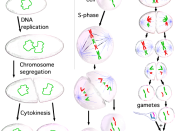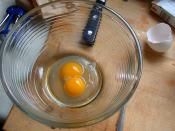A bacterium is a single, prokaryotic cell. It has a cell wall but lacks a nucleus and membrane - bound organelles. A bacterium's single DNA molecule is not coiled around proteins to form chromosomes. Instead, its face of the plasma membrane like a rope attached to the inner wall of a tent. First the DNA is copied, and then the cell splits.
Before a bacterium can divide it must have two copies of its DNA so that each of the new two cells will have a complete copy of the genetic information of that bacterium. To make a copy of itself, the DNA molecule begins to "unzip" lengthwise, exposing its two strands. As this happens, each strand is made into a complete DNA molecule. Shortly after it has entirely unzipped, the cell has two identical copies of its hereditary information, attached side by side to the interior plasma membrane.
Once the DNA has been copied and the cell has grown to an appropriate size, the bacterium splits into two equal halves through a process called binary fission. Binary Fission is a form of asexual reproduction that produces identical offspring. First, a new plasma membrane is added at a point on the membrane between the two DNA copies. As new material is added in this zone, the growing plasma membrane pushes inward and the cell is constricted in two, like a long balloon being squeezed around its middle. A new cell wall forms around the new membrane. Eventually the dividing bacterium is pinched into two independent cells. Each cell contains one of the circles of DNA.
The cells of eukaryotic organisms (protists, fungi, plants, and animals) have a far more complex internal structure than that of the simple cells of bacteria. Cell division in eukaryotic cells must take into account...



Bio notes on genetics
Why can't people get it through their heads??? These are notes not essays, and along the guidelines for quality notes, these are top notch.
These notes, as all of ccmustangs2001's notes, are informative, detailed, thorough and well written. They provide a great resource for research and studying.
How is they say?..."Keep on truckin'", ccmustangs2001.
2 out of 3 people found this comment useful.